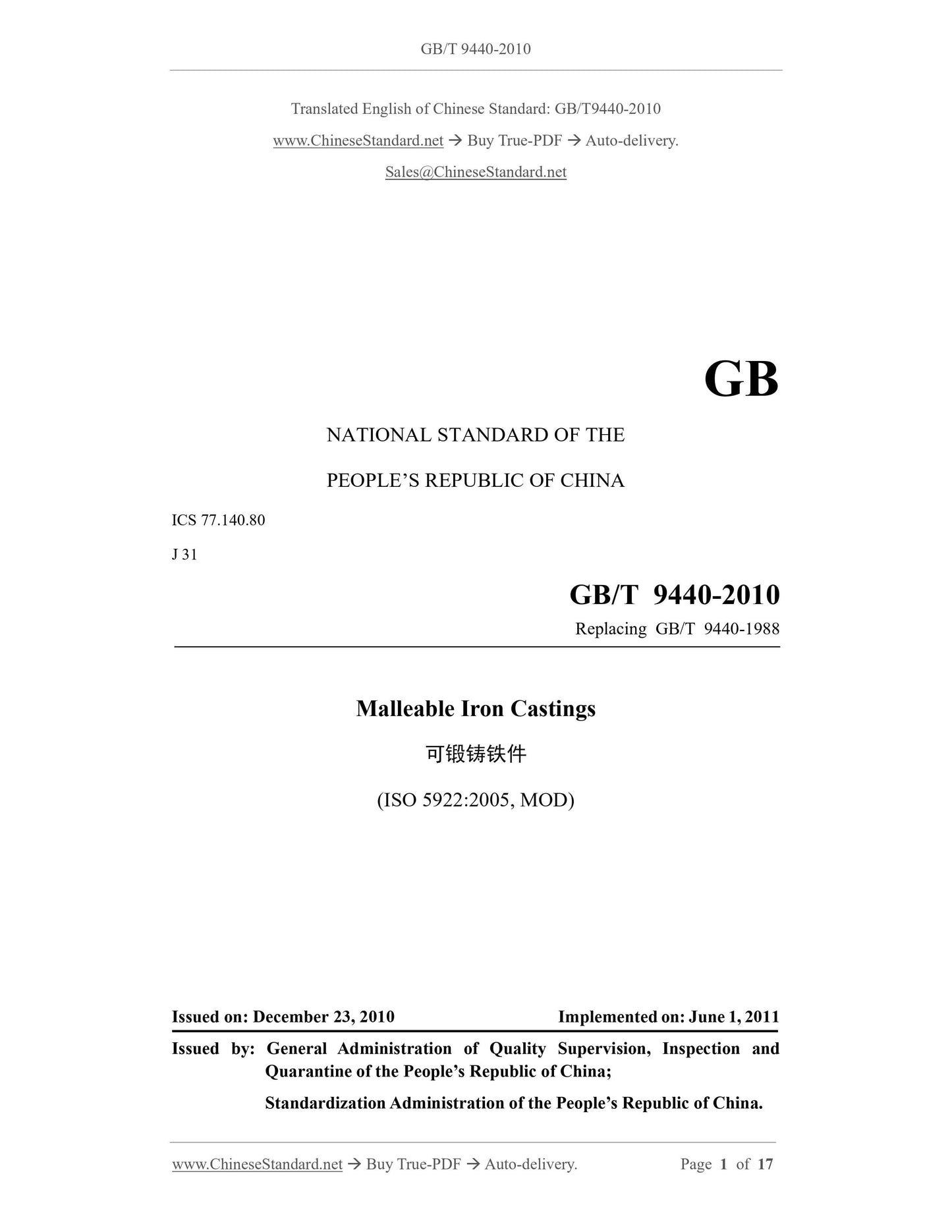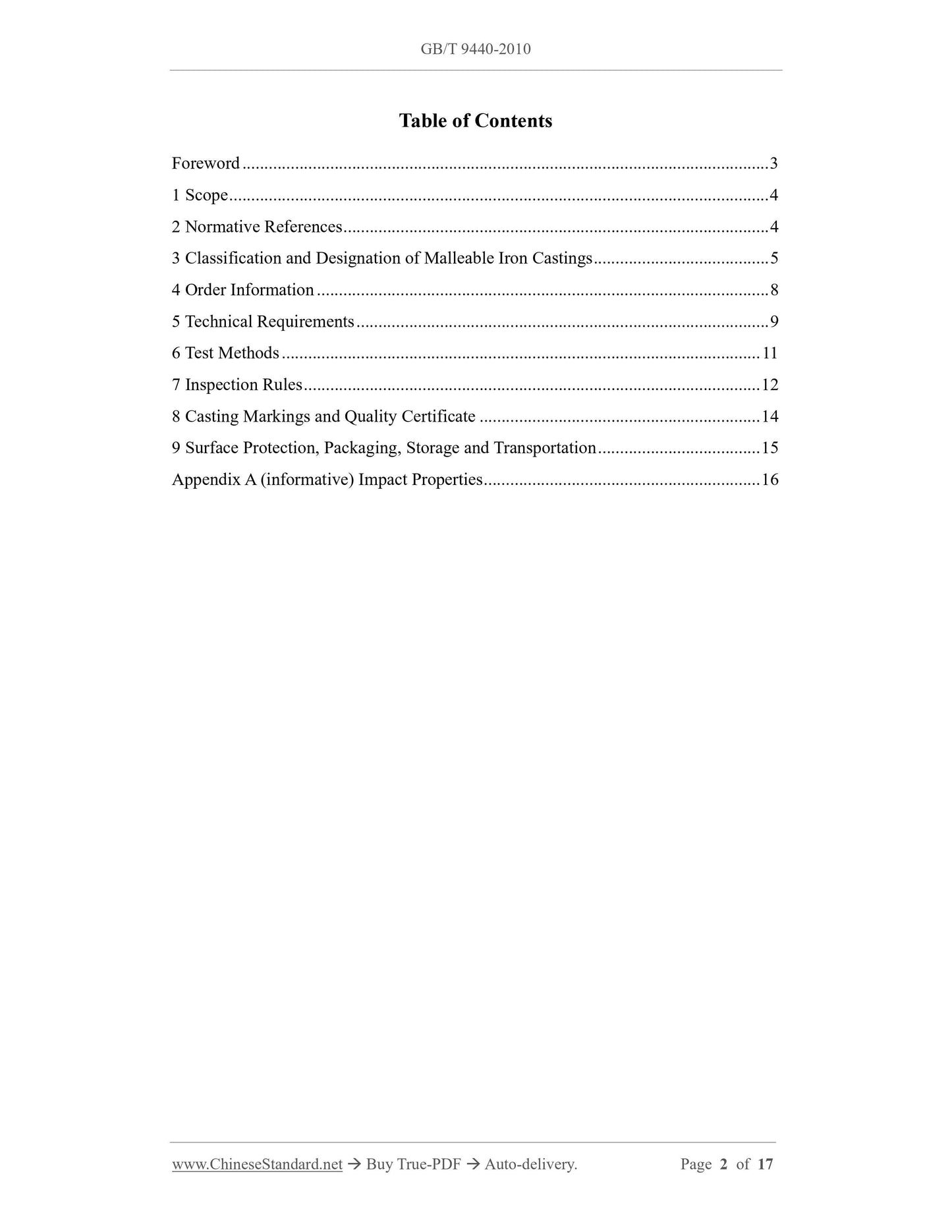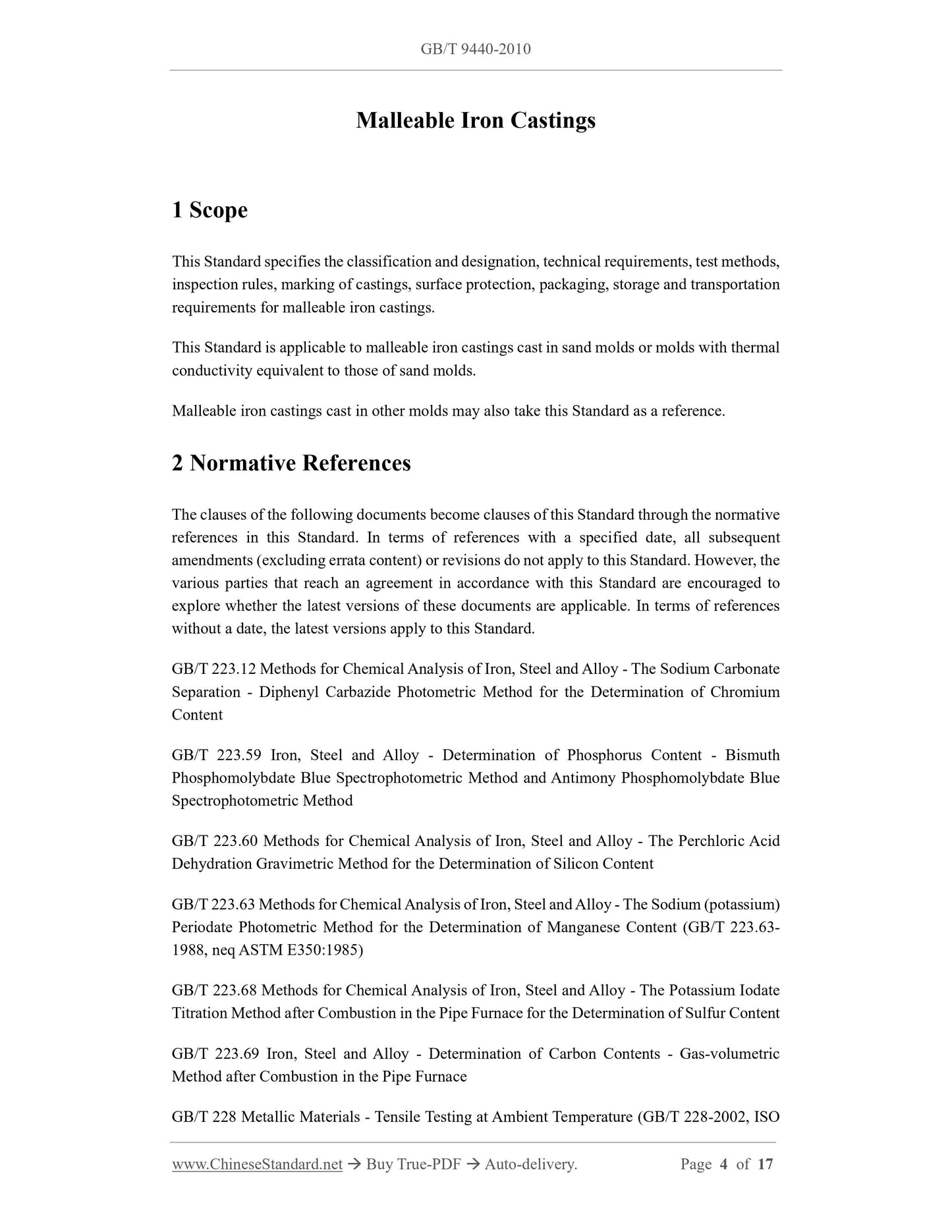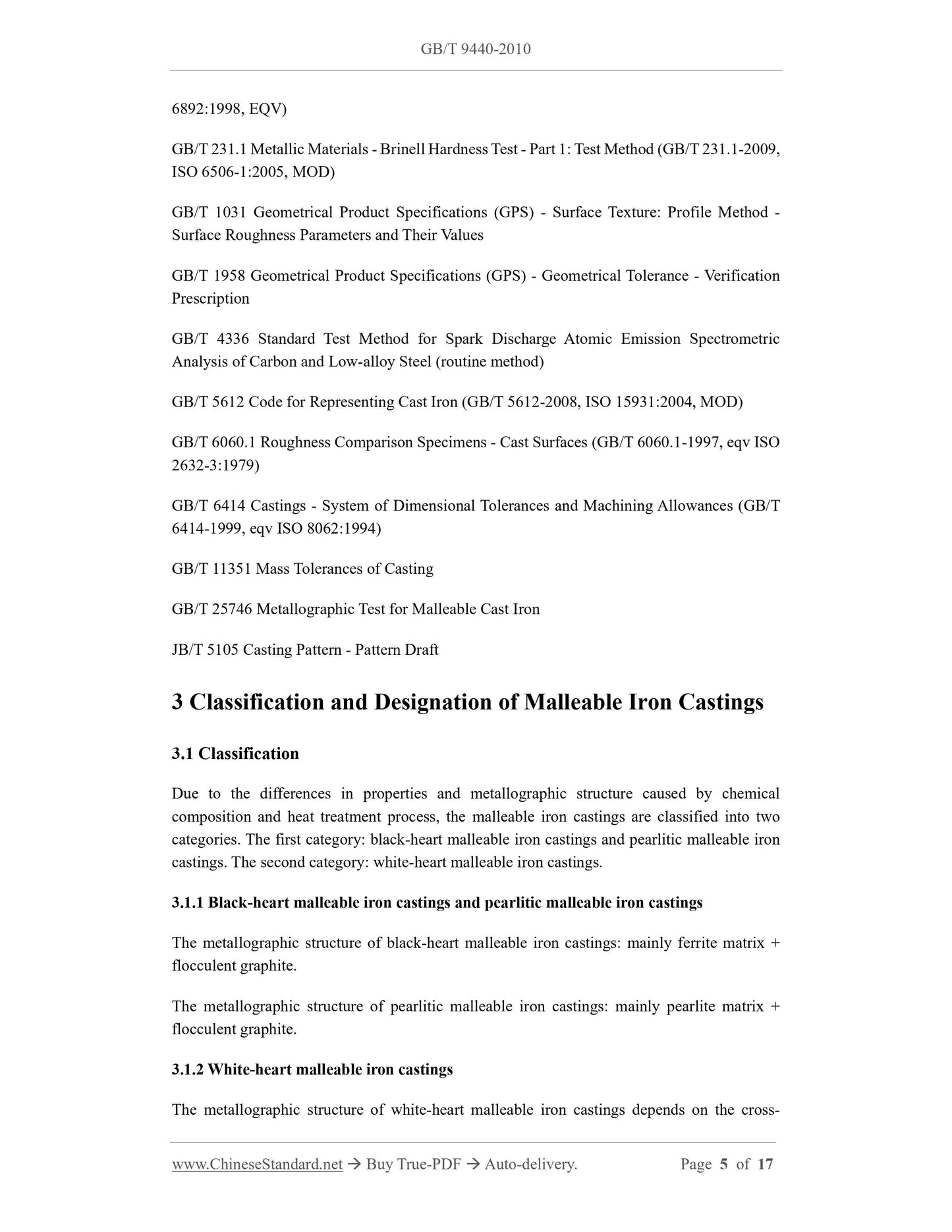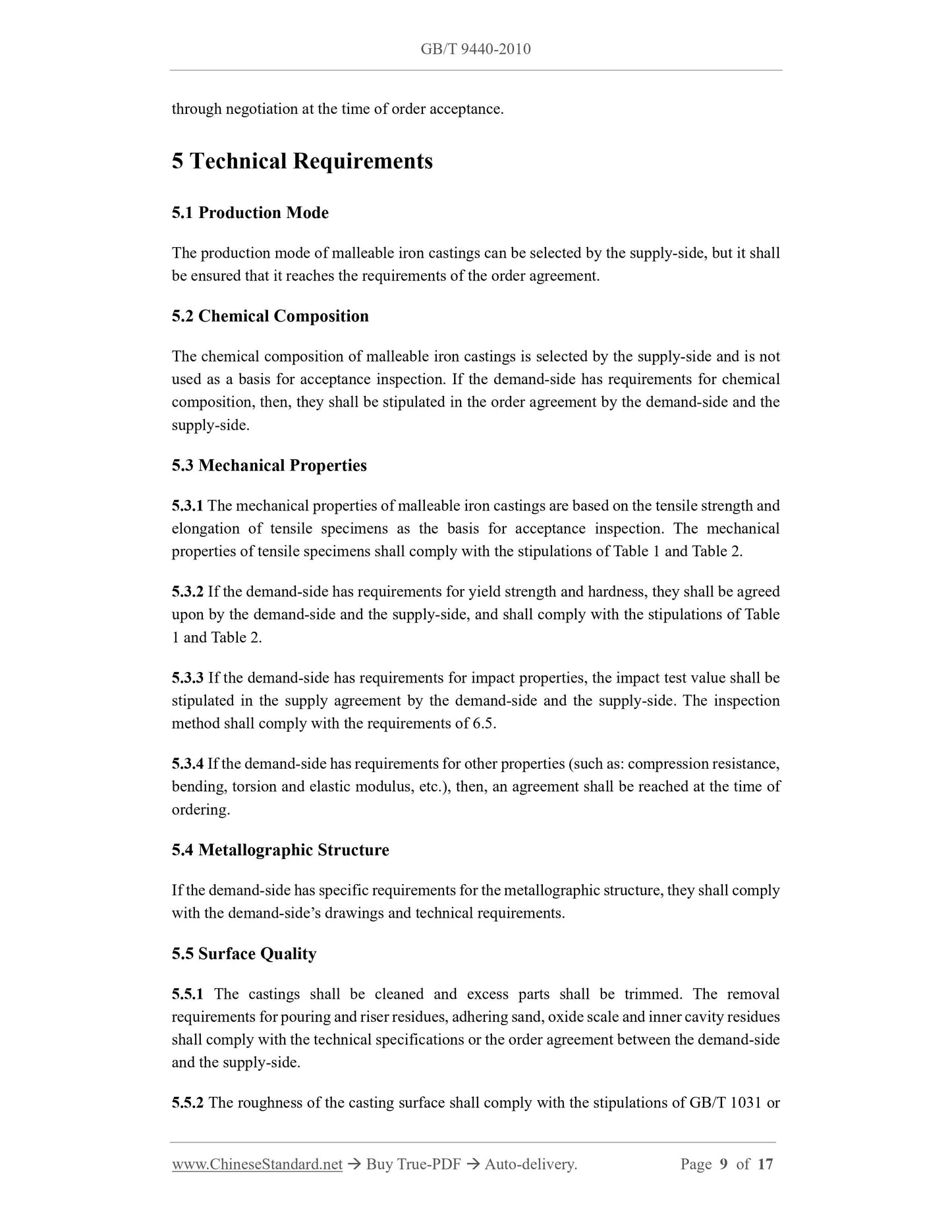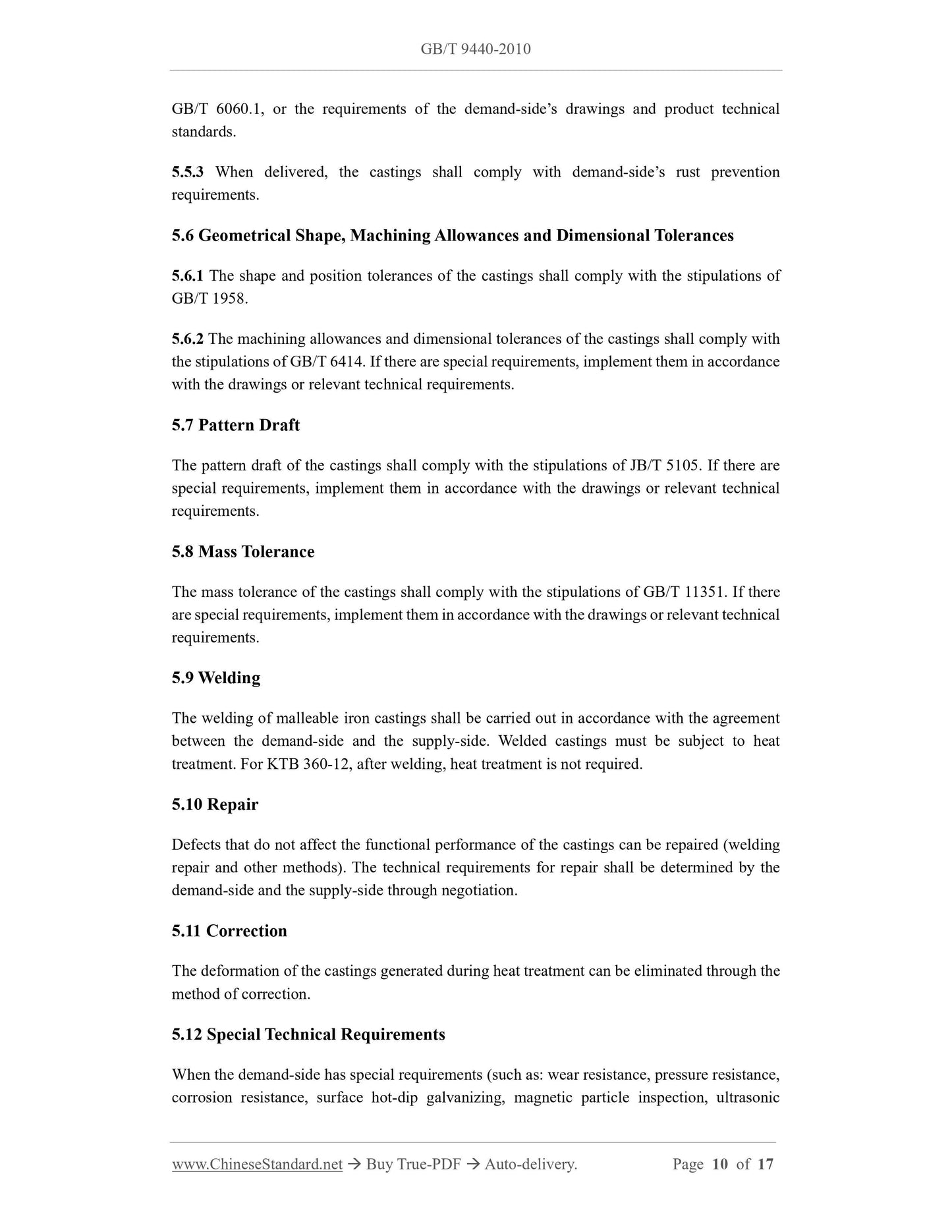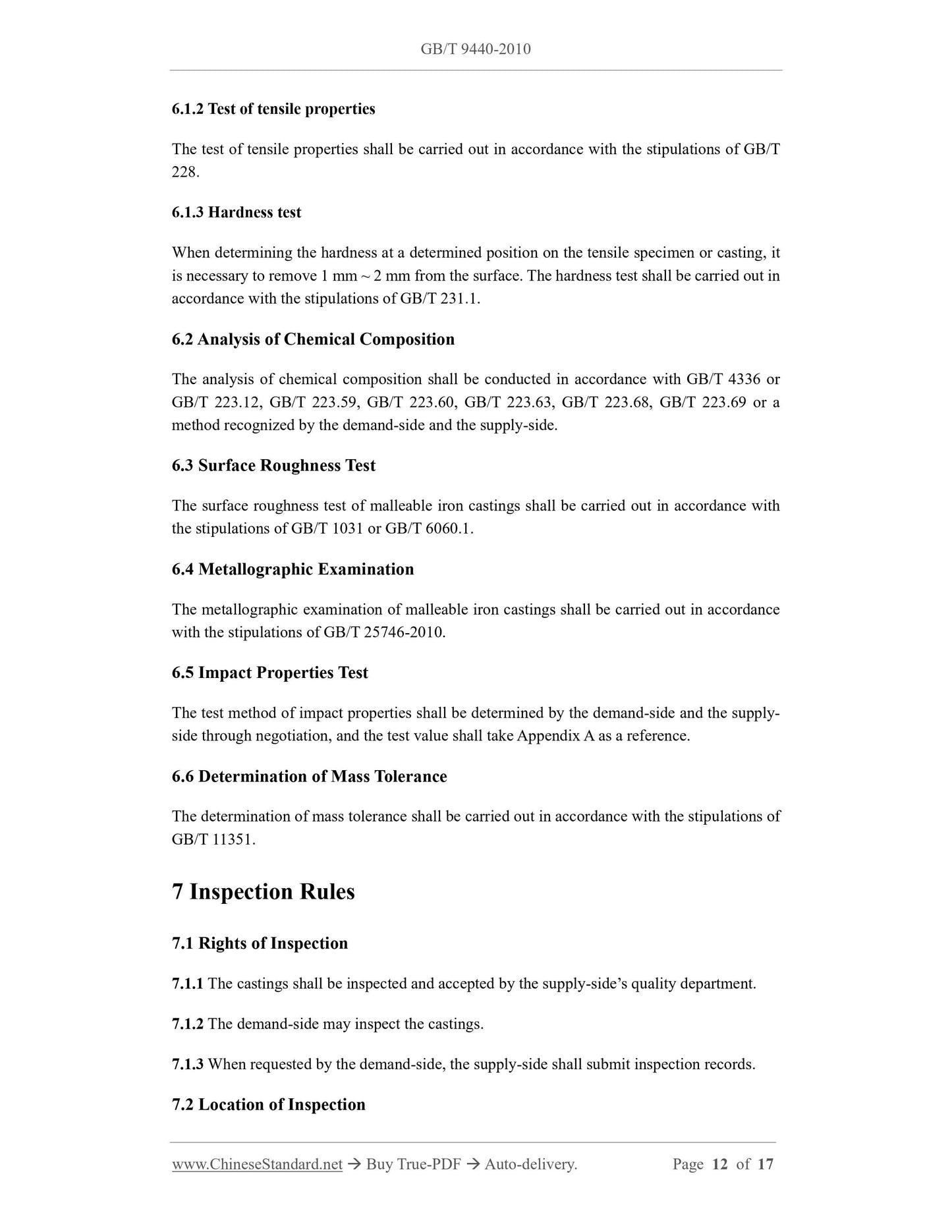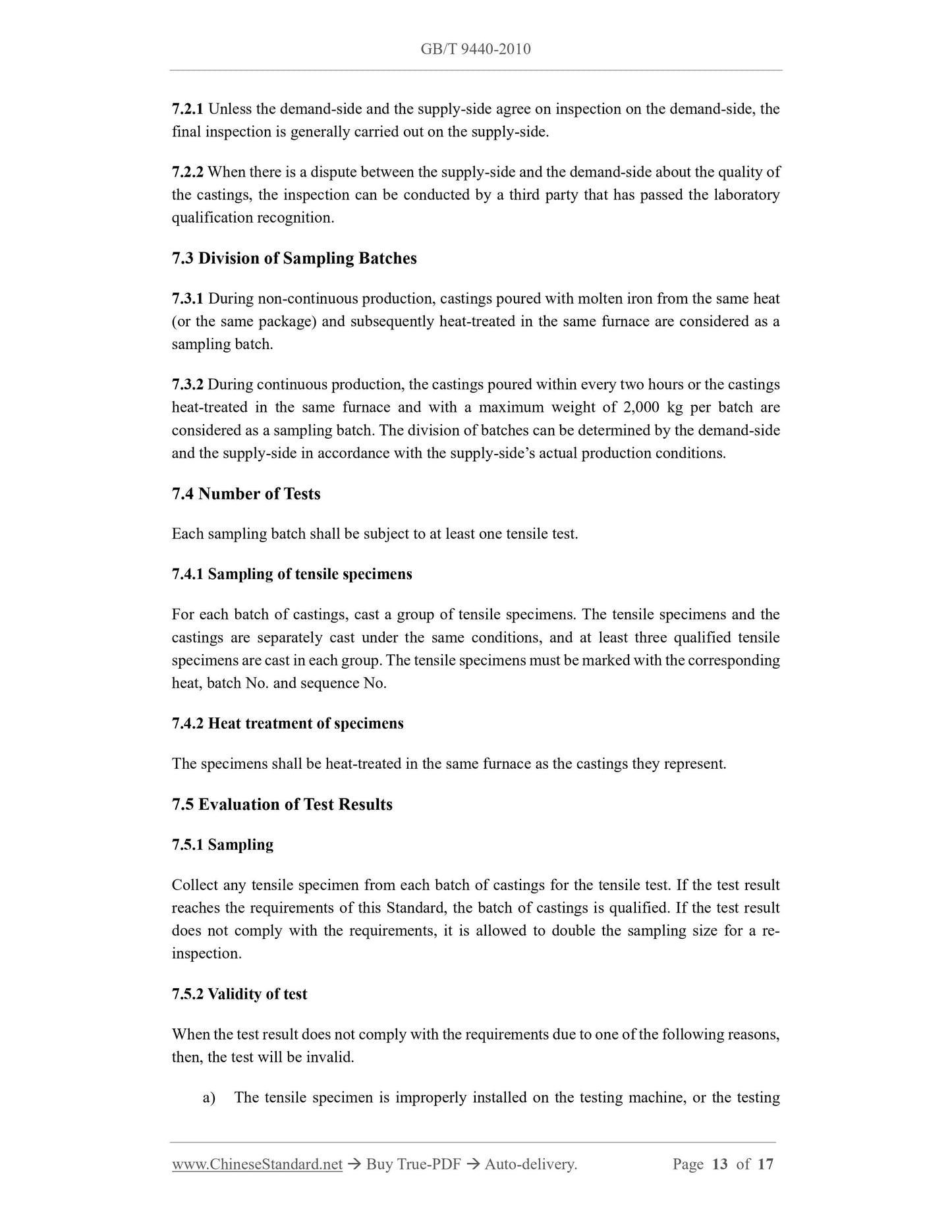1
/
of
8
www.ChineseStandard.us -- Field Test Asia Pte. Ltd.
GB/T 9440-2010 English PDF (GB/T9440-2010)
GB/T 9440-2010 English PDF (GB/T9440-2010)
Regular price
$220.00
Regular price
Sale price
$220.00
Unit price
/
per
Shipping calculated at checkout.
Couldn't load pickup availability
GB/T 9440-2010: Malleable iron castings
Delivery: 9 seconds. Download (& Email) true-PDF + Invoice.
Get Quotation: Click GB/T 9440-2010 (Self-service in 1-minute)
Historical versions (Master-website): GB/T 9440-2010
Preview True-PDF (Reload/Scroll-down if blank)
GB/T 9440-2010
GB
NATIONAL STANDARD OF THE
PEOPLE’S REPUBLIC OF CHINA
ICS 77.140.80
J 31
Replacing GB/T 9440-1988
Malleable Iron Castings
(ISO 5922:2005, MOD)
ISSUED ON: DECEMBER 23, 2010
IMPLEMENTED ON: JUNE 1, 2011
Issued by: General Administration of Quality Supervision, Inspection and
Quarantine of the People’s Republic of China;
Standardization Administration of the People’s Republic of China.
Table of Contents
Foreword ... 3
1 Scope ... 4
2 Normative References ... 4
3 Classification and Designation of Malleable Iron Castings ... 5
4 Order Information ... 8
5 Technical Requirements ... 9
6 Test Methods ... 11
7 Inspection Rules ... 12
8 Casting Markings and Quality Certificate ... 14
9 Surface Protection, Packaging, Storage and Transportation ... 15
Appendix A (informative) Impact Properties ... 16
Malleable Iron Castings
1 Scope
This Standard specifies the classification and designation, technical requirements, test methods,
inspection rules, marking of castings, surface protection, packaging, storage and transportation
requirements for malleable iron castings.
This Standard is applicable to malleable iron castings cast in sand molds or molds with thermal
conductivity equivalent to those of sand molds.
Malleable iron castings cast in other molds may also take this Standard as a reference.
2 Normative References
The clauses of the following documents become clauses of this Standard through the normative
references in this Standard. In terms of references with a specified date, all subsequent
amendments (excluding errata content) or revisions do not apply to this Standard. However, the
various parties that reach an agreement in accordance with this Standard are encouraged to
explore whether the latest versions of these documents are applicable. In terms of references
without a date, the latest versions apply to this Standard.
GB/T 223.12 Methods for Chemical Analysis of Iron, Steel and Alloy - The Sodium Carbonate
Separation - Diphenyl Carbazide Photometric Method for the Determination of Chromium
Content
GB/T 223.59 Iron, Steel and Alloy - Determination of Phosphorus Content - Bismuth
Phosphomolybdate Blue Spectrophotometric Method and Antimony Phosphomolybdate Blue
Spectrophotometric Method
GB/T 223.60 Methods for Chemical Analysis of Iron, Steel and Alloy - The Perchloric Acid
Dehydration Gravimetric Method for the Determination of Silicon Content
GB/T 223.63 Methods for Chemical Analysis of Iron, Steel and Alloy - The Sodium (potassium)
Periodate Photometric Method for the Determination of Manganese Content (GB/T 223.63-
1988, neq ASTM E350:1985)
GB/T 223.68 Methods for Chemical Analysis of Iron, Steel and Alloy - The Potassium Iodate
Titration Method after Combustion in the Pipe Furnace for the Determination of Sulfur Content
GB/T 223.69 Iron, Steel and Alloy - Determination of Carbon Contents - Gas-volumetric
Method after Combustion in the Pipe Furnace
GB/T 228 Metallic Materials - Tensile Testing at Ambient Temperature (GB/T 228-2002, ISO
6892:1998, EQV)
GB/T 231.1 Metallic Materials - Brinell Hardness Test - Part 1: Test Method (GB/T 231.1-2009,
ISO 6506-1:2005, MOD)
GB/T 1031 Geometrical Product Specifications (GPS) - Surface Texture: Profile Method -
Surface Roughness Parameters and Their Values
GB/T 1958 Geometrical Product Specifications (GPS) - Geometrical Tolerance - Verification
Prescription
GB/T 4336 Standard Test Method for Spark Discharge Atomic Emission Spectrometric
Analysis of Carbon and Low-alloy Steel (routine method)
GB/T 5612 Code for Representing Cast Iron (GB/T 5612-2008, ISO 15931:2004, MOD)
GB/T 6060.1 Roughness Comparison Specimens - Cast Surfaces (GB/T 6060.1-1997, eqv ISO
2632-3:1979)
GB/T 6414 Castings - System of Dimensional Tolerances and Machining Allowances (GB/T
6414-1999, eqv ISO 8062:1994)
GB/T 11351 Mass Tolerances of Casting
GB/T 25746 Metallographic Test for Malleable Cast Iron
JB/T 5105 Casting Pattern - Pattern Draft
3 Classification and Designation of Malleable Iron Castings
3.1 Classification
Due to the differences in properties and metallographic structure caused by chemical
composition and heat treatment process, the malleable iron castings are classified into two
categories. The first category: black-heart malleable iron castings and pearlitic malleable iron
castings. The second category: white-heart malleable iron castings.
3.1.1 Black-heart malleable iron castings and pearlitic malleable iron castings
The metallographic structure of black-heart malleable iron castings: mainly ferrite matrix +
flocculent graphite.
The metallographic structure of pearlitic malleable iron castings: mainly pearlite matrix +
flocculent graphite.
3.1.2 White-heart malleable iron castings
The metallographic structure of white-heart malleable iron castings depends on the cross-
through negotiation at the time of order acceptance.
5 Technical Requirements
5.1 Production Mode
The production mode of malleable iron castings can be selected by the supply-side, but it shall
be ensured that it reaches the requirements of the order agreement.
5.2 Chemical Composition
The chemical composition of malleable iron castings is selected by the supply-side and is not
used as a basis for acceptance inspection. If the demand-side has requirements for chemical
composition, then, they shall be stipulated in the order agreement by the demand-side and the
supply-side.
5.3 Mechanical Properties
5.3.1 The mechanical properties of malleable iron castings are based on the tensile strength and
elongation of tensile specimens as the basis for acceptance inspection. The mechanical
properties of tensile specimens shall comply with the stipulations of Table 1 and Table 2.
5.3.2 If the demand-side has requirements for yield strength and hardness, they shall be agreed
upon by the demand-side and the supply-side, and shall comply with the stipulations of Table
1 and Table 2.
5.3.3 If the demand-side has requirements for impact properties, the impact test value shall be
stipulated in the supply agreement by the demand-side and the supply-side. The inspection
method shall comply with the requirements of 6.5.
5.3.4 If the demand-side has requirements for other properties (such as: compression resistance,
bending, torsion and elastic modulus, etc.), then, an agreement shall be reached at the time of
ordering.
5.4 Metallographic Structure
If the demand-side has specific requirements for the metallographic structure, they shall comply
with the demand-side’s drawings and technical requirements.
5.5 Surface Quality
5.5.1 The castings shall be cleaned and excess parts shall be trimmed. The removal
requirements for pouring and riser residues, adhering sand, oxide scale and inner cavity residues
shall comply with the technical specifications or the order agreement between the demand-side
and the supply-side.
5.5.2 The roughness of the casting surface shall comply with the stipulations of GB/T 1031 or
GB/T 6060.1, or the requirements of the demand-side’s drawings and product technical
standards.
5.5.3 When delivered, the castings shall comply with demand-side’s rust prevention
requirements.
5.6 Geometrical Shape, Machining Allowances and Dimensional Tolerances
5.6.1 The shape and position tolerances of the castings shall comply with the stipulations of
GB/T 1958.
5.6.2 The machining allowances and dimensional tolerances of the castings shall comply with
the stipulations of GB/T 6414. If there are special requirements, implement them in accordance
with the drawings or relevant technical requirements.
5.7 Pattern Draft
The pattern draft of the castings shall comply with the stipulations of JB/T 5105. If there are
special requirements, implement them in accordance with the drawings or relevant technical
requirements.
5.8 Mass Tolerance
The mass tolerance of the castings shall comply with the stipulations of GB/T 11351. If there
are special requirements, implement them in accordance with the drawings or relevant technical
requirements.
5.9 Welding
The welding of malleable iron castings shall be carried out in accordance with the agreement
between the demand-side and the supply-side. Welded castings must be subject to heat
treatment. For KTB 360-12, after welding, heat treatment is not required.
5.10 Repair
Defects that do not affect the functional performance of the castings can be repaired (welding
repair and other methods). The technical requirements for repair shall be determined by the
demand-side and the supply-side through negotiation.
5.11 Correction
The deformation of the castings generated during heat treatment can be eliminated through the
method of correction.
5.12 Special Technical Requirements
When the demand-side has special requirements (such as: wear resistance, pressure resistance,
corrosion resistance, surface hot-dip galvanizing, magnetic particle inspection, ultrasonic
6.1.2 Test of tensile properties
The test of tensile properties shall be carried out in accordance with the stipulations of GB/T
228.
6.1.3 Hardness test
When determining the hardness at a determined position on the tensile specimen or casting, it
is necessary to remove 1 mm ~ 2 mm from the surface. The hardness test shall be carried out in
accordance with the stipulations of GB/T 231.1.
6.2 Analysis of Chemical Composition
The analysis of chemical composition shall be conducted in accordance with GB/T 4336 or
GB/T 223.12, GB/T 223.59, GB/T 223.60, GB/T 223.63, GB/T 223.68, GB/T 223.69 or a
method recognized by the demand-side and the supply-side.
6.3 Surface Roughness Test
The surface roughness test of malleable iron castings shall be carried out in accordance with
the stipulations of GB/T 1031 or GB/T 6060.1.
6.4 Metallographic Examination
The metallographic examination of malleable iron castings shall be carried out in accordance
with the stipulations of GB/T 25746-2010.
6.5 Impact Properties Test
The test method of impact properties shall be determined by the demand-side and the supply-
side through negotiation, and the test value shall take Appendix A as a reference.
6.6 Determination of Mass Tolerance
The determination of mass tolerance shall be carried out in accordance with the stipulations of
GB/T 11351.
7 Inspection Rules
7.1 Rights of Inspection
7.1.1 The castings shall be inspected and accepted by the supply-side’s quality department.
7.1.2 The demand-side may inspect the castings.
7.1.3 When requested by the demand-side, the supply-side shall submit inspection records.
7.2 Location of Inspection
7.2.1 Unless the demand-side and the supply-side agree on inspection on the demand-side, the
final inspection is generally carried out on the supply-side.
7.2.2 When there is a dispute between the supply-side and the demand-side about the quality of
the castings, the inspection can be conducted by a third party that has passed the laboratory
qualification recognition.
7.3 Division of Sampling Batches
7.3.1 During non-continuous production, castings poured with molten iron from the same heat
(or the same package) and subsequently heat-treated in the same furnace are considered as a
sampling batch.
7.3.2 During continuous production, the castings poured within every two hours or the castings
heat-treated in the same furnace and with a maximum weight of 2,000 kg per batch are
considered as a sampling batch. The division of batches can be determined by the demand-side
and the supply-side in accordance with the supply-side’s actual production conditions.
7.4 Number of Tests
Each sampling batch shall be subject to at least one tensile test.
7.4.1 Sampling of tensile specimens
For each batch of castings, cast a group of tensile specimens. The tensile specimens and the
castings are separately cast under the same conditions, and at least three qualified tensile
specimens are cast in each group. The tensile specimens must be marked with the corresponding
heat, batch No. and sequence No.
7.4.2 Heat treatment of specimens
The specimens shall be heat-treated in the same furnace as the castings they represent.
7.5 Evaluation of Test Results
7.5.1 Sampling
Collect any tensile specimen from each batch of castings for the tensile test. If the test result
reaches the requirements of this Standard, the batch of castings is qualified. If the test result
does not comply with the requirements, it is allowed to double the sampling size for a re-
inspection.
7.5.2 Validity of test
When the test result does not comply with the requirements due to one of the following reasons,
then, the test will be invalid.
a) The tensile specimen is improperly installed on the testing machine, or the testing
GB/T 9440-2010
GB
NATIONAL STANDARD OF THE
PEOPLE’S REPUBLIC OF CHINA
ICS 77.140.80
J 31
Replacing GB/T 9440-1988
Malleable Iron Castings
(ISO 5922:2005, MOD)
ISSUED ON: DECEMBER 23, 2010
IMPLEMENTED ON: JUNE 1, 2011
Issued by: General Administration of Quality Supervision, Inspection and
Quarantine of the People’s Republic of China;
Standardization Administration of the People’s Republic of China.
Table of Contents
Foreword ... 3
1 Scope ... 4
2 Normative References ... 4
3 Classification and Designation of Malleable Iron Castings ... 5
4 Order Information ... 8
5 Technical Requirements ... 9
6 Test Methods ... 11
7 Inspection Rules ... 12
8 Casting Markings and Quality Certificate ... 14
9 Surface Protection, Packaging, Storage and Transportation ... 15
Appendix A (informative) Impact Properties ... 16
Malleable Iron Castings
1 Scope
This Standard specifies the classification and designation, technical requirements, test methods,
inspection rules, marking of castings, surface protection, packaging, storage and transportation
requirements for malleable iron castings.
This Standard is applicable to malleable iron castings cast in sand molds or molds with thermal
conductivity equiv...
Delivery: 9 seconds. Download (& Email) true-PDF + Invoice.
Get Quotation: Click GB/T 9440-2010 (Self-service in 1-minute)
Historical versions (Master-website): GB/T 9440-2010
Preview True-PDF (Reload/Scroll-down if blank)
GB/T 9440-2010
GB
NATIONAL STANDARD OF THE
PEOPLE’S REPUBLIC OF CHINA
ICS 77.140.80
J 31
Replacing GB/T 9440-1988
Malleable Iron Castings
(ISO 5922:2005, MOD)
ISSUED ON: DECEMBER 23, 2010
IMPLEMENTED ON: JUNE 1, 2011
Issued by: General Administration of Quality Supervision, Inspection and
Quarantine of the People’s Republic of China;
Standardization Administration of the People’s Republic of China.
Table of Contents
Foreword ... 3
1 Scope ... 4
2 Normative References ... 4
3 Classification and Designation of Malleable Iron Castings ... 5
4 Order Information ... 8
5 Technical Requirements ... 9
6 Test Methods ... 11
7 Inspection Rules ... 12
8 Casting Markings and Quality Certificate ... 14
9 Surface Protection, Packaging, Storage and Transportation ... 15
Appendix A (informative) Impact Properties ... 16
Malleable Iron Castings
1 Scope
This Standard specifies the classification and designation, technical requirements, test methods,
inspection rules, marking of castings, surface protection, packaging, storage and transportation
requirements for malleable iron castings.
This Standard is applicable to malleable iron castings cast in sand molds or molds with thermal
conductivity equivalent to those of sand molds.
Malleable iron castings cast in other molds may also take this Standard as a reference.
2 Normative References
The clauses of the following documents become clauses of this Standard through the normative
references in this Standard. In terms of references with a specified date, all subsequent
amendments (excluding errata content) or revisions do not apply to this Standard. However, the
various parties that reach an agreement in accordance with this Standard are encouraged to
explore whether the latest versions of these documents are applicable. In terms of references
without a date, the latest versions apply to this Standard.
GB/T 223.12 Methods for Chemical Analysis of Iron, Steel and Alloy - The Sodium Carbonate
Separation - Diphenyl Carbazide Photometric Method for the Determination of Chromium
Content
GB/T 223.59 Iron, Steel and Alloy - Determination of Phosphorus Content - Bismuth
Phosphomolybdate Blue Spectrophotometric Method and Antimony Phosphomolybdate Blue
Spectrophotometric Method
GB/T 223.60 Methods for Chemical Analysis of Iron, Steel and Alloy - The Perchloric Acid
Dehydration Gravimetric Method for the Determination of Silicon Content
GB/T 223.63 Methods for Chemical Analysis of Iron, Steel and Alloy - The Sodium (potassium)
Periodate Photometric Method for the Determination of Manganese Content (GB/T 223.63-
1988, neq ASTM E350:1985)
GB/T 223.68 Methods for Chemical Analysis of Iron, Steel and Alloy - The Potassium Iodate
Titration Method after Combustion in the Pipe Furnace for the Determination of Sulfur Content
GB/T 223.69 Iron, Steel and Alloy - Determination of Carbon Contents - Gas-volumetric
Method after Combustion in the Pipe Furnace
GB/T 228 Metallic Materials - Tensile Testing at Ambient Temperature (GB/T 228-2002, ISO
6892:1998, EQV)
GB/T 231.1 Metallic Materials - Brinell Hardness Test - Part 1: Test Method (GB/T 231.1-2009,
ISO 6506-1:2005, MOD)
GB/T 1031 Geometrical Product Specifications (GPS) - Surface Texture: Profile Method -
Surface Roughness Parameters and Their Values
GB/T 1958 Geometrical Product Specifications (GPS) - Geometrical Tolerance - Verification
Prescription
GB/T 4336 Standard Test Method for Spark Discharge Atomic Emission Spectrometric
Analysis of Carbon and Low-alloy Steel (routine method)
GB/T 5612 Code for Representing Cast Iron (GB/T 5612-2008, ISO 15931:2004, MOD)
GB/T 6060.1 Roughness Comparison Specimens - Cast Surfaces (GB/T 6060.1-1997, eqv ISO
2632-3:1979)
GB/T 6414 Castings - System of Dimensional Tolerances and Machining Allowances (GB/T
6414-1999, eqv ISO 8062:1994)
GB/T 11351 Mass Tolerances of Casting
GB/T 25746 Metallographic Test for Malleable Cast Iron
JB/T 5105 Casting Pattern - Pattern Draft
3 Classification and Designation of Malleable Iron Castings
3.1 Classification
Due to the differences in properties and metallographic structure caused by chemical
composition and heat treatment process, the malleable iron castings are classified into two
categories. The first category: black-heart malleable iron castings and pearlitic malleable iron
castings. The second category: white-heart malleable iron castings.
3.1.1 Black-heart malleable iron castings and pearlitic malleable iron castings
The metallographic structure of black-heart malleable iron castings: mainly ferrite matrix +
flocculent graphite.
The metallographic structure of pearlitic malleable iron castings: mainly pearlite matrix +
flocculent graphite.
3.1.2 White-heart malleable iron castings
The metallographic structure of white-heart malleable iron castings depends on the cross-
through negotiation at the time of order acceptance.
5 Technical Requirements
5.1 Production Mode
The production mode of malleable iron castings can be selected by the supply-side, but it shall
be ensured that it reaches the requirements of the order agreement.
5.2 Chemical Composition
The chemical composition of malleable iron castings is selected by the supply-side and is not
used as a basis for acceptance inspection. If the demand-side has requirements for chemical
composition, then, they shall be stipulated in the order agreement by the demand-side and the
supply-side.
5.3 Mechanical Properties
5.3.1 The mechanical properties of malleable iron castings are based on the tensile strength and
elongation of tensile specimens as the basis for acceptance inspection. The mechanical
properties of tensile specimens shall comply with the stipulations of Table 1 and Table 2.
5.3.2 If the demand-side has requirements for yield strength and hardness, they shall be agreed
upon by the demand-side and the supply-side, and shall comply with the stipulations of Table
1 and Table 2.
5.3.3 If the demand-side has requirements for impact properties, the impact test value shall be
stipulated in the supply agreement by the demand-side and the supply-side. The inspection
method shall comply with the requirements of 6.5.
5.3.4 If the demand-side has requirements for other properties (such as: compression resistance,
bending, torsion and elastic modulus, etc.), then, an agreement shall be reached at the time of
ordering.
5.4 Metallographic Structure
If the demand-side has specific requirements for the metallographic structure, they shall comply
with the demand-side’s drawings and technical requirements.
5.5 Surface Quality
5.5.1 The castings shall be cleaned and excess parts shall be trimmed. The removal
requirements for pouring and riser residues, adhering sand, oxide scale and inner cavity residues
shall comply with the technical specifications or the order agreement between the demand-side
and the supply-side.
5.5.2 The roughness of the casting surface shall comply with the stipulations of GB/T 1031 or
GB/T 6060.1, or the requirements of the demand-side’s drawings and product technical
standards.
5.5.3 When delivered, the castings shall comply with demand-side’s rust prevention
requirements.
5.6 Geometrical Shape, Machining Allowances and Dimensional Tolerances
5.6.1 The shape and position tolerances of the castings shall comply with the stipulations of
GB/T 1958.
5.6.2 The machining allowances and dimensional tolerances of the castings shall comply with
the stipulations of GB/T 6414. If there are special requirements, implement them in accordance
with the drawings or relevant technical requirements.
5.7 Pattern Draft
The pattern draft of the castings shall comply with the stipulations of JB/T 5105. If there are
special requirements, implement them in accordance with the drawings or relevant technical
requirements.
5.8 Mass Tolerance
The mass tolerance of the castings shall comply with the stipulations of GB/T 11351. If there
are special requirements, implement them in accordance with the drawings or relevant technical
requirements.
5.9 Welding
The welding of malleable iron castings shall be carried out in accordance with the agreement
between the demand-side and the supply-side. Welded castings must be subject to heat
treatment. For KTB 360-12, after welding, heat treatment is not required.
5.10 Repair
Defects that do not affect the functional performance of the castings can be repaired (welding
repair and other methods). The technical requirements for repair shall be determined by the
demand-side and the supply-side through negotiation.
5.11 Correction
The deformation of the castings generated during heat treatment can be eliminated through the
method of correction.
5.12 Special Technical Requirements
When the demand-side has special requirements (such as: wear resistance, pressure resistance,
corrosion resistance, surface hot-dip galvanizing, magnetic particle inspection, ultrasonic
6.1.2 Test of tensile properties
The test of tensile properties shall be carried out in accordance with the stipulations of GB/T
228.
6.1.3 Hardness test
When determining the hardness at a determined position on the tensile specimen or casting, it
is necessary to remove 1 mm ~ 2 mm from the surface. The hardness test shall be carried out in
accordance with the stipulations of GB/T 231.1.
6.2 Analysis of Chemical Composition
The analysis of chemical composition shall be conducted in accordance with GB/T 4336 or
GB/T 223.12, GB/T 223.59, GB/T 223.60, GB/T 223.63, GB/T 223.68, GB/T 223.69 or a
method recognized by the demand-side and the supply-side.
6.3 Surface Roughness Test
The surface roughness test of malleable iron castings shall be carried out in accordance with
the stipulations of GB/T 1031 or GB/T 6060.1.
6.4 Metallographic Examination
The metallographic examination of malleable iron castings shall be carried out in accordance
with the stipulations of GB/T 25746-2010.
6.5 Impact Properties Test
The test method of impact properties shall be determined by the demand-side and the supply-
side through negotiation, and the test value shall take Appendix A as a reference.
6.6 Determination of Mass Tolerance
The determination of mass tolerance shall be carried out in accordance with the stipulations of
GB/T 11351.
7 Inspection Rules
7.1 Rights of Inspection
7.1.1 The castings shall be inspected and accepted by the supply-side’s quality department.
7.1.2 The demand-side may inspect the castings.
7.1.3 When requested by the demand-side, the supply-side shall submit inspection records.
7.2 Location of Inspection
7.2.1 Unless the demand-side and the supply-side agree on inspection on the demand-side, the
final inspection is generally carried out on the supply-side.
7.2.2 When there is a dispute between the supply-side and the demand-side about the quality of
the castings, the inspection can be conducted by a third party that has passed the laboratory
qualification recognition.
7.3 Division of Sampling Batches
7.3.1 During non-continuous production, castings poured with molten iron from the same heat
(or the same package) and subsequently heat-treated in the same furnace are considered as a
sampling batch.
7.3.2 During continuous production, the castings poured within every two hours or the castings
heat-treated in the same furnace and with a maximum weight of 2,000 kg per batch are
considered as a sampling batch. The division of batches can be determined by the demand-side
and the supply-side in accordance with the supply-side’s actual production conditions.
7.4 Number of Tests
Each sampling batch shall be subject to at least one tensile test.
7.4.1 Sampling of tensile specimens
For each batch of castings, cast a group of tensile specimens. The tensile specimens and the
castings are separately cast under the same conditions, and at least three qualified tensile
specimens are cast in each group. The tensile specimens must be marked with the corresponding
heat, batch No. and sequence No.
7.4.2 Heat treatment of specimens
The specimens shall be heat-treated in the same furnace as the castings they represent.
7.5 Evaluation of Test Results
7.5.1 Sampling
Collect any tensile specimen from each batch of castings for the tensile test. If the test result
reaches the requirements of this Standard, the batch of castings is qualified. If the test result
does not comply with the requirements, it is allowed to double the sampling size for a re-
inspection.
7.5.2 Validity of test
When the test result does not comply with the requirements due to one of the following reasons,
then, the test will be invalid.
a) The tensile specimen is improperly installed on the testing machine, or the testing
GB/T 9440-2010
GB
NATIONAL STANDARD OF THE
PEOPLE’S REPUBLIC OF CHINA
ICS 77.140.80
J 31
Replacing GB/T 9440-1988
Malleable Iron Castings
(ISO 5922:2005, MOD)
ISSUED ON: DECEMBER 23, 2010
IMPLEMENTED ON: JUNE 1, 2011
Issued by: General Administration of Quality Supervision, Inspection and
Quarantine of the People’s Republic of China;
Standardization Administration of the People’s Republic of China.
Table of Contents
Foreword ... 3
1 Scope ... 4
2 Normative References ... 4
3 Classification and Designation of Malleable Iron Castings ... 5
4 Order Information ... 8
5 Technical Requirements ... 9
6 Test Methods ... 11
7 Inspection Rules ... 12
8 Casting Markings and Quality Certificate ... 14
9 Surface Protection, Packaging, Storage and Transportation ... 15
Appendix A (informative) Impact Properties ... 16
Malleable Iron Castings
1 Scope
This Standard specifies the classification and designation, technical requirements, test methods,
inspection rules, marking of castings, surface protection, packaging, storage and transportation
requirements for malleable iron castings.
This Standard is applicable to malleable iron castings cast in sand molds or molds with thermal
conductivity equiv...
Share
